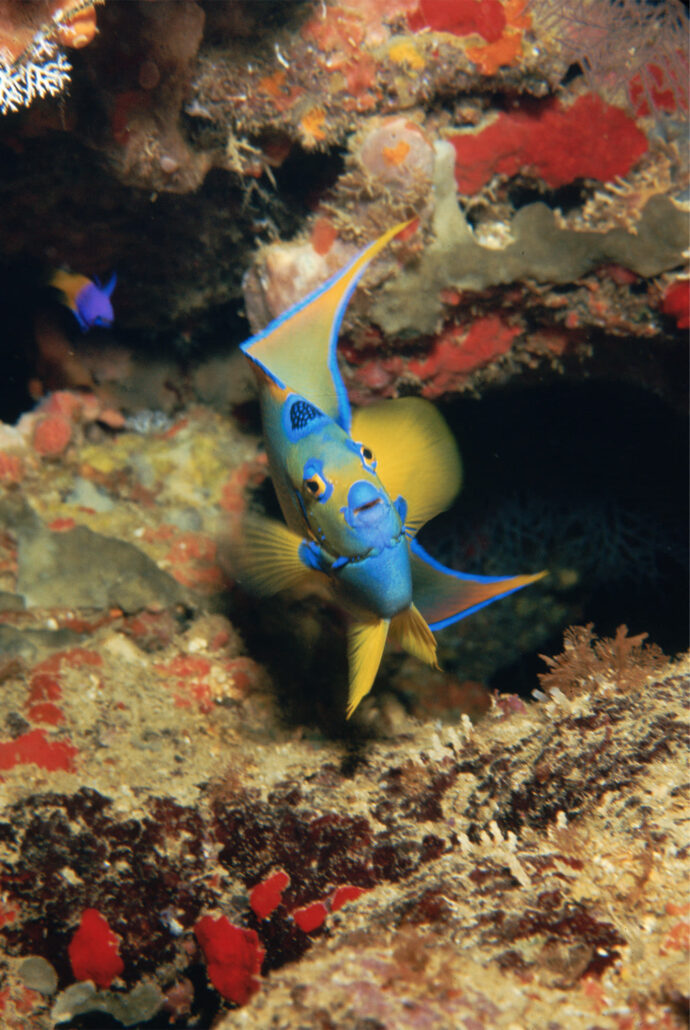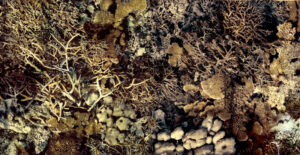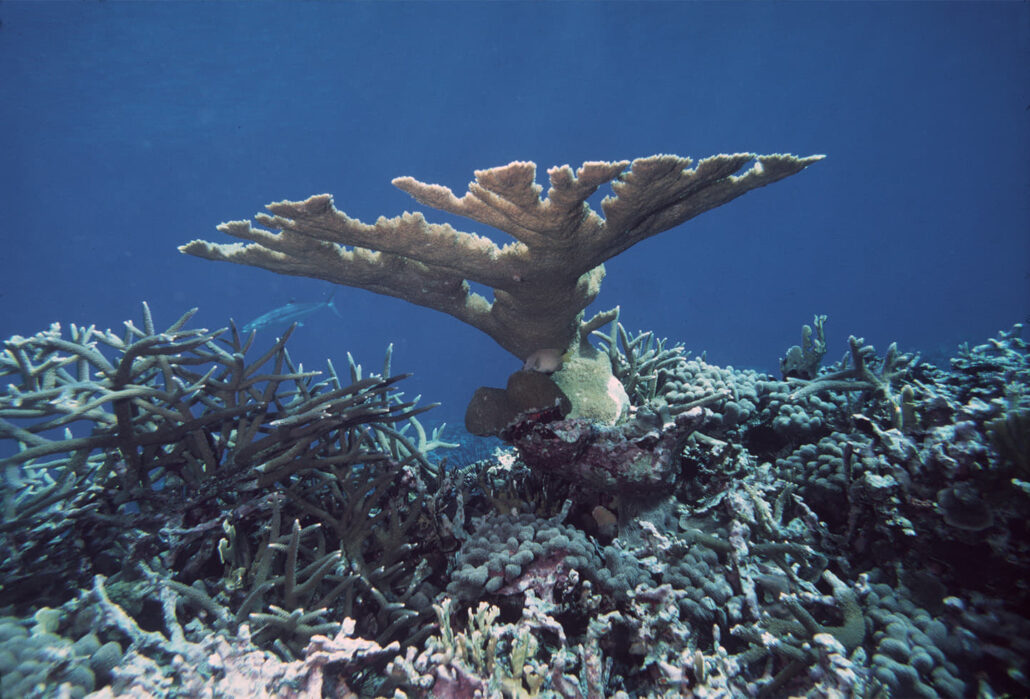Picture this: A coffee-table book of stunning and alarming photographs for you, for free
Editor’s Note: Classmates Bill Sacco, a professional photographer, and Jim Porter, a Ph.D. scientist, have been working hard to bring Bill’s stunningly beautiful coffee-table book, A Photographic Guide to the Caribbean Coral Reef, to a bookstore near you.
When this book is printed, its 200+ pages and more than 500 color photographs will drive the cover price quite high. But Bill has generously offered all classmates early-bird access to a high-resolution pdf of the final draft for FREE!
Read on and download your copy at the end of this post.
 Bill Sacco and I took our first dive in the frigid waters of the Long Island Sound in March of 1968. He needed mud samples for a geology project. What I remember most, though, was not our shivering adventure, but the warm and luminous photographs Bill took of lobsterpot floats hanging haphazardly on a boathouse wall next to the dive site.
Bill Sacco and I took our first dive in the frigid waters of the Long Island Sound in March of 1968. He needed mud samples for a geology project. What I remember most, though, was not our shivering adventure, but the warm and luminous photographs Bill took of lobsterpot floats hanging haphazardly on a boathouse wall next to the dive site.
As you will see in the pages of this book, Bill knows how to take good photographs. He always has.
During our last year at Yale, Bill and I created a photography course, one of the first of the college seminars, for Silliman Salamanders, and we found some staff photographers from LIFE magazine to be instructors. One of them, their primary scientific photographer, Fritz Goro, insisted that a good picture was not just an accurate rendition of the subject. It had to tell a story. It had to create an emotional bond between viewer and subject. It had to connect the viewer’s heart to the viewer’s mind.
Bill’s images do this. Fritz would be proud of this book.
While working as a Yale photographer since 1969, Bill also made photographs for LIFE, Smithsonian, and other clients, eventually retiring as a Yale photographer after 46 years, 30 of which were spent at the Peabody Museum.
Below you’ll be able to download the publication-ready final draft of the book and see the stunning images and compelling tale told in A Photographic Guide to the Caribbean Coral Reef.
Using photographs Bill made between 1968 and 1978, the Guide presents in compelling narrative and vivid color the stunning beauty of Caribbean coral reefs, as they existed in the 60s and 70s. The overall impact is a powerful conservation message to preserve and protect these biologically diverse, and yet critically endangered, ecosystems.
 After graduation, I stayed at Yale and received a Ph.D. in Ecology in 1973 where I specialized in coral reef ecology. Bill and I have stayed close over the years, connected by our appreciation of coral, both of us originally working as field assistants in the Caribbean. I’ve become an advocate and activist, e.g., testifying before Congress five times, most recently on global biodiversity loss and threats to planetary sustainability caused by Global Climate Change. At the last reunion, you may have seen my screening of our wonderful documentary on the decline of coral reefs, Chasing Coral. It was a winner of Sundance, Peabody and Emmy Awards, and is now available on Netflix. I served as Chief Science Advisor and a principal cast member on the film.
After graduation, I stayed at Yale and received a Ph.D. in Ecology in 1973 where I specialized in coral reef ecology. Bill and I have stayed close over the years, connected by our appreciation of coral, both of us originally working as field assistants in the Caribbean. I’ve become an advocate and activist, e.g., testifying before Congress five times, most recently on global biodiversity loss and threats to planetary sustainability caused by Global Climate Change. At the last reunion, you may have seen my screening of our wonderful documentary on the decline of coral reefs, Chasing Coral. It was a winner of Sundance, Peabody and Emmy Awards, and is now available on Netflix. I served as Chief Science Advisor and a principal cast member on the film.
I want to see Bill’s book published because coral reefs are important! Coral reefs are in trouble! I hope it will build awareness and increase motivation to address climate change very aggressively.
Some of the beauty of coral reefs can be seen in Bill’s stunning portraits of marine sea creatures. By any measure, coral reefs are the most extraordinary ecosystem on Earth:
- Although reefs cover only 1% of the planet, they house twenty-five percent of all marine organisms in them.
- Eighty-five percent of the time that a new Family, Order, Class, or Phylum appeared on Planet Earth, it did so first on coral reefs.
- Coral reefs are the only living things that are so large it can be seen from outer space.
- Coral reefs are the most productive of all marine communities. Unlike highly-productive areas created by humans, like wheat fields, cornfields, or rice paddies, coral reefs achieve their high productivity by including a myriad of other species in their biodiverse seascape.
- Coral reefs are also the oldest ecosystem on Earth, with a continuous fossil record of more than 500 million years.
Clearly, we humans have much to learn from coral reefs.
Although I am primarily a scientist and Bill is primarily an artist, we both fight for coral reefs using images. During my Congressional testimony last year on Capitol Hill, I got audible gasps from the Members of Congress by showing these “before and after” images of coral reef loss. As the “Before” image slowly faded away, only to be replaced in a montage by this “After” image, no one shouted, “fake news!” Bill and I both know that seeing is believing. This is the power of art!


We have a world to save. Helping to get Bill’s book published will go a long way to getting the word out.
Jim Porter / Athens, GA
Download Your Copy here:
Heads Up! These are high-resolution, full-color images and the .pdf is BIG … 398 megabytes! So be careful if you are mobile/roaming and paying for bandwidth. Be patient, too!
Depending on your browser, you’ll need to either left-click on the link, or right-click on it and “save target as …”
Download A Photographic Guide to the Caribbean Coral Reef here.




Wow! Run don’t walk to download a copy of this most gracious offer. And please honor Bill’s request to refrain from passing this along to just a couple of your friends.
Rather tell them how to buy a copy…